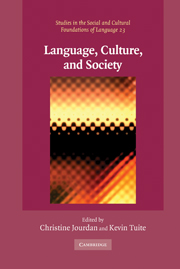Book contents
- Frontmatter
- Contents
- List of tables
- List of contributors
- Acknowledgments
- Introduction: Walking through walls
- 1 An issue about language
- 2 Linguistic relativities
- 3 Benjamin Lee Whorf and the Boasian foundations of contemporary ethnolinguistics
- 4 Cognitive anthropology
- 5 Methodological issues in cross-language color naming
- 6 Pidgins and creoles genesis: an anthropological offering
- 7 Bilingualism
- 8 The impact of language socialization on grammatical development
- 9 Intimate grammars: anthropological and psychoanalytic accounts of language, gender, and desire
- 10 Maximizing ethnopoetics: fine-tuning anthropological experience
- 11 Interpreting language variation and change
- References
- Index
- STUDIES IN THE SOCIAL AND CULTURAL FOUNDATIONS OF LANGUAGE
Introduction: Walking through walls
Published online by Cambridge University Press: 16 November 2009
- Frontmatter
- Contents
- List of tables
- List of contributors
- Acknowledgments
- Introduction: Walking through walls
- 1 An issue about language
- 2 Linguistic relativities
- 3 Benjamin Lee Whorf and the Boasian foundations of contemporary ethnolinguistics
- 4 Cognitive anthropology
- 5 Methodological issues in cross-language color naming
- 6 Pidgins and creoles genesis: an anthropological offering
- 7 Bilingualism
- 8 The impact of language socialization on grammatical development
- 9 Intimate grammars: anthropological and psychoanalytic accounts of language, gender, and desire
- 10 Maximizing ethnopoetics: fine-tuning anthropological experience
- 11 Interpreting language variation and change
- References
- Index
- STUDIES IN THE SOCIAL AND CULTURAL FOUNDATIONS OF LANGUAGE
Summary
In an interview recorded in 1994, André-Georges Haudricourt described himself as a “passe-muraille,” a person capable of walking through walls (Bertrand 2002: 251). The passe-muraille, best known to French readers from the short story of that name by Marcel Aymé, is both marvelous and disquieting, a transgressive being – in both senses of the word – who refuses to acknowledge the barriers that contain and channel the movements of others. Haudricourt clearly had this complex of senses in mind when he chose the word to characterize his atypical career in French academia: an agronomy graduate who subsequently studied under Marcel Mauss, Haudricourt went on to conduct important research in such diverse fields as ethnoscience, phonological theory and the history of agriculture, often to the discomfiture of his more sessile colleagues.
For much of the past century, to say nothing of the present one, there has been a great deal of talk about the desirability of interdisciplinarity, and of breaking down the walls that impede communication between adjoining academic fields. The discipline of anthropology, as conceived (and exemplified) by Franz Boas, was to be just such a wall-less meeting place, where ethnologists, archaeologists, linguists, and physical anthropologists would collaboratively grapple with the complexities of human diversity (see, e.g. Boas 1899). Boas's vision took institutional form as the “four-field” or “Boasian” anthropology departments of many North American universities, where course offerings, faculty recruitment, and even the composition of internal committees conform to the principle of an asymmetrical confederation of canton-like subdisciplines, with social-cultural anthropology as the primus inter pares.
- Type
- Chapter
- Information
- Language, Culture, and SocietyKey Topics in Linguistic Anthropology, pp. 1 - 15Publisher: Cambridge University PressPrint publication year: 2006
- 1
- Cited by

